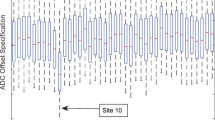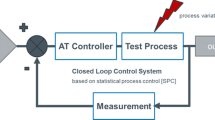Abstract
Test setup limitations, such as noise and parasitics, increasingly impede repeatable and accurate linearity measurements in high-volume production testing of high-precision data converters. Model-based testing has been shown to reduce the adverse effects of noise [14].
In this work, we present two enhancements of the linear model-based approach: one is a change of the modeling strategy in order to account for measurement errors induced, for example, by parasitics associated with the device contactor, and another is a Design-for-Test feature that significantly improves the model’s ability to reduce the effect of measurement noise on the accuracy of the test outcome.
Similar content being viewed by others
References
J. Bastos, A.M. Marques, M.S.J. Steyaert, and W. Sansen, “A 12-Bit Intrinsic Accuracy High-Speed CMOS DAC,” J. of Solid-State Circuits, vol. 33, no. 12, pp. 1959–1969, 1998.
B. Brost, “Reducing the Cost of Semiconductor Testing with High-Performance Contacting Technology,” Semiconductor Fabtech Journal, vol. 4, 1996.
M. Burns and G.W. Roberts, An Introduction to Mixed-Signal IC Test and Measurement. Oxford series in Electrical and Computer Engineering, 1st edition, New York: Oxford University Press, 2001.
G.H. Golub and C.F. van Loan, Matrix Computations, Johns Hopkins Univ. Press, Baltimore, 3rd edition, 1996.
D.A. Johns and K. Martin, Analog Integrated Circuit Design, John Wiley & Sons, Inc., 1997.
K. Kataoka, T. Itoh, K. Okumura, and T. Suga, “Low Contact Force Probing on Copper Electrodes,” in Proc. ITC, Int. Test Conf., Baltimore, MD, USA, Oct. 2002, pp. 424–429.
G. Maugard, C. Wegener, T. O’Dwyer, and M.P. Kennedy, “Reducing Contactor-Induced Linearity Testing Error for High-Precision, Medium-Speed ADCs,” in Proc. ITC, Int. Test Conf., Charlotte, NC, USA, Oct. 2003, pp. 210–217.
J.W. Silverstein and P.L. Combettes, “Large Dimensional Random Matrix Theory for Signal Detection and Estimation in Array Processing,” in SSAP, Workshop on Statistical Signal and Array Processing, Victoria, B.C., Canada, Oct. 1992, pp. 276–279.
G.W. Steward, Linear Algebra for Large Scale and Real-Time Applications, chapter Determining Rank in the Presence of Error, pp. 1–20. NATO Workshop on Large Scale Linear Algebra. Kluwer Academic Publishers, Dordrecht, 1992.
The Institute of Electrical and Electronics Engineers, Inc., New York. IEEE Std 1241-2000, Dec. 2000. IEEE standard for terminology and test methods for analog-to-digital converters.
M. van Bossche, J. Schoukens, and J. Renneboog, “Dynamic Testing and Diagnostics of A/D Converters,” Trans. on Circuits and Systems, vol. CAS-33, no. 8, pp. 775–785, 1986.
C. Wegener, “Applications of Linear Modeling to Testing and Characterizing D/A and A/D Converters,” PhD thesis, University College Cork, Dept. Microelectr. Eng., Nov. 2003.
C. Wegener and M.P. Kennedy, “Implementation of Model-Based Testing for Medium- to High-Resolution Nyquist-Rate ADCs,” in Proc. ITC, Int. Test Conf., Baltimore, MD, Oct. 2002, pp. 851–860.
C. Wegener and M.P. Kennedy, “Linear Model-Based Testing of ADC Nonlinearities,” Trans. on Circuits and Systems I, vol. 51, no. 1, pp. 213–217, 2004.
R.H. Williams and C.F. Hawkins, “The Economics of Guardband Placement,” in Proc. ITC, Int. Test Conf., 1993, pp. 218–224.
Author information
Authors and Affiliations
Corresponding author
Additional information
The authors acknowledge the support by Analog Devices B.V., Limerick, Ireland and Enterprise Ireland under the Strategic Research Grant ST/00/26.
Carsten Wegener has been awarded the academic degree of a “Diplom-Ingenieur” in Electronic Circuits and Systems by the Technical University of Dresden, Germany, in 1997. During a period of two years, 1996 through 1998, he attended the lecture series for the “Vordiplom” in Mathematics at Humboldt-University at Berlin, Germany.
In Spring 1998, he moved permanently to Ireland, where he started to work with the Test Department of Analog Devices B.V. in Limerick. In Autumn of the same year he took up his PhD-studies with Dr M.P. Kennedy in the area of model-based testing of mixed-signal integrated circuits. He has been awarded the PhD degree by the National University of Ireland in December 2003.
He has contributed to numerous conferences, publishing works in areas of nonlinear oscillator dynamics and mixed-signal testing. In Ireland, he has taught MATLAB courses to design and test engineers at Analog Devices B.V., and graduate courses on “Digital Design-for-Test” and “Mixed-signal Test and Testability” at the Department of Microelectronic Engineering, University College Cork.
Michael Peter Kennedy received the B.E. degree in electronics from the National University of Ireland in 1984, and the M.S. and Ph.D. degrees from the University of California at Berkeley (UC Berkeley) in 1987 and 1991, respectively, for his contributions to the study of neural networks and nonlinear dynamics.
He worked as a Design Engineer with Philips Electronics, a Postdoctoral Research Engineer with the Electronics Research Laboratory, UC Berkeley, and as a Professeur Invité with the EPFL, Switzerland. He returned to University College Dublin in 1992 as a College Lecturer in the Department of Electronic and Electrical Engineering. He was appointed Professor of Microelectronic Engineering at University College Cork in 2000.
He has published 200 articles in the area of nonlinear circuits and systems and has taught courses on nonlinear dynamics and chaos. His research interests are nonlinear circuits and systems for applications in communications and signal processing. Since 1995 he has been active in research into algorithms for mixed-signal testing. Since 1994, he has led international basic and applied research projects on chaotic communications valued at over USD 2M.
Dr. Kennedy was elected a Fellow of the IEEE in 1998. He received the Third Millenium Medal from the IEEE in 2000, the IEEE Circuits and Systems Society Golden Jubilee Medal, and the inaugural Parson’s Award for excellence in Engineering Sciences from the Royal Irish Academy in 2001.
Rights and permissions
About this article
Cite this article
Wegener, C., Kennedy, M.P. Overcoming Test Setup Limitations by Applying Model-Based Testing to High-Precision ADCs. J Electron Test 21, 299–310 (2005). https://doi.org/10.1007/s10836-005-6359-3
Received:
Revised:
Issue Date:
DOI: https://doi.org/10.1007/s10836-005-6359-3




